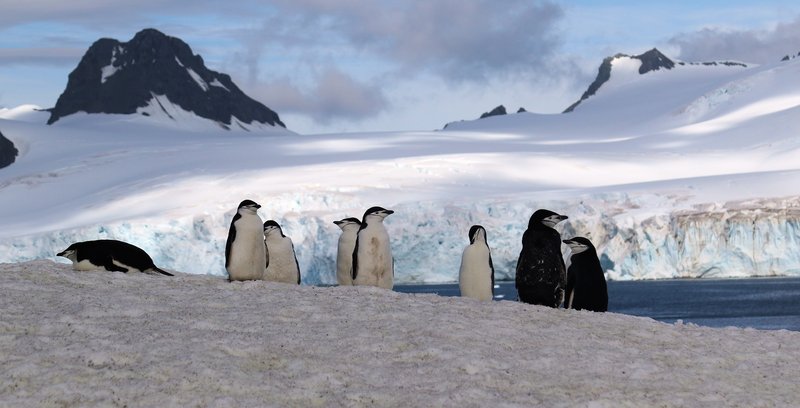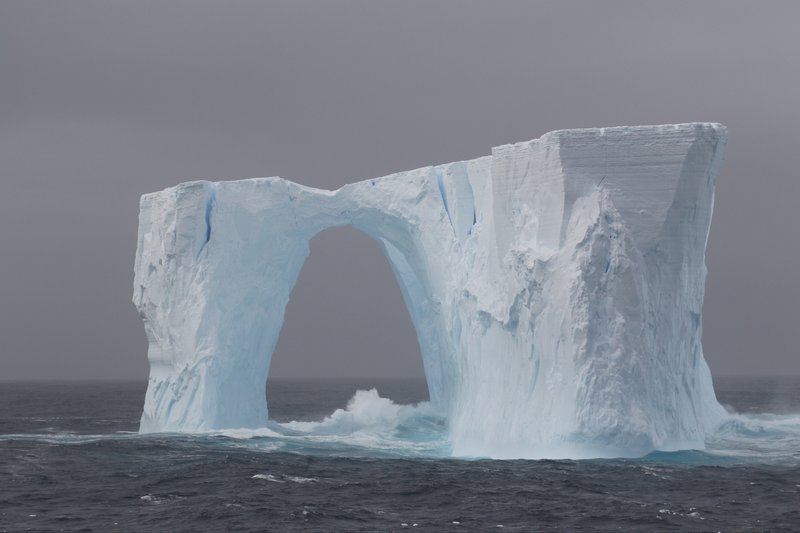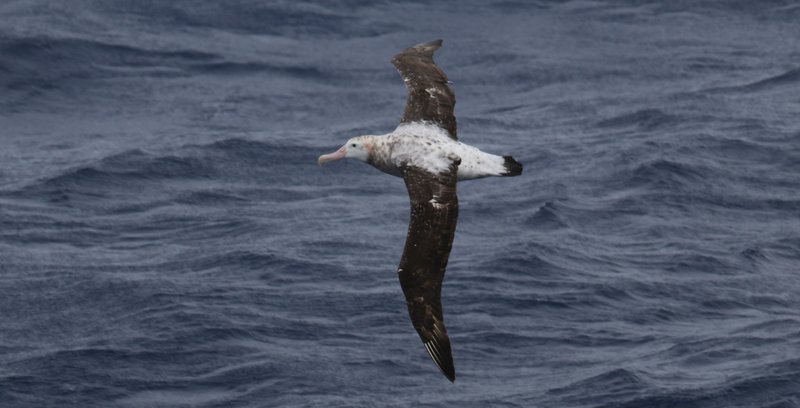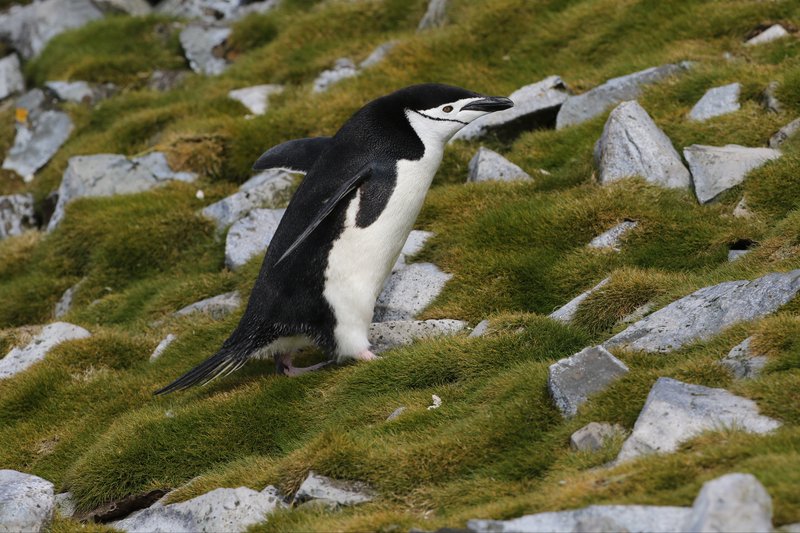Visiting Antarctica – an Introduction

During the summer months, the Brown Skuas regularly “attack” the Gentoo Penguin colonies attempting to steal both eggs and younger chicks.
Antarctica is like nowhere else on Earth, a huge continent of dramatic ice-covered mountains, vast snowfields, innumerable glaciers, colossal icebergs and some fantastic wildlife, making this a truly unique holiday to a location which only a tiny percentage of the world’s population has been privileged enough to visit.
Generally, the season begins in November and runs until March and every month has its own special highlights. For those visiting at the beginning of the season, there is a lot more snow and ice (especially in the South Shetland Islands) and the penguins will have only just started to nest. By Christmas, it is mid-summer in the southern hemisphere (with almost 24 hours daylight) and the first of the Gentoo Penguin chicks will be hatching. It is then a constant rush for the adult birds to fetch food for their youngsters, dodging the attention of Orcas and Leopard Seals in the water and Brown Skua ashore. Depending on the location, the chicks will typically start to form creches in January and by early March, tranquillity returns to the beaches as the birds head to sea for the winter.

Chinstrap Penguins in the South Shetland Islands
Antarctica is, however, about so much more than ‘just penguins’ and it is almost impossible to put into words, the breath-taking scenery of this very special place. Ice and snow will be a constant feature as your ship cruises between landing sites and on most occasions, you can expect two activities each day with these being a combination of landings and zodiac cruises.

Occasionally some amazing icebergs are encountered in the Drake Passage
Whilst every voyage is unique, most will offer you the opportunity to visit colonies of Chinstrap, Adelie and Gentoo Penguins. There are also excellent chances of Weddell and Crabeater Seals and as the days slowly start to shorten, the chances of finding Leopard and Antarctic Fur Seals generally increases. Almost irrespective of when you visit, you can expect to see Humpback Whales (with the highest numbers being at the end of the summer) and whilst wildlife can never be guaranteed, there are also opportunities to see Orca (Killer Whales) throughout the summer months.
As well as visiting the Antarctic Peninsula, most expeditions also make landings in the South Shetland Islands which are a little to the north of the Peninsula and have a marginally milder climate. For birders, a stop here is important to see Chinstrap Penguins, as these are much less numerous around the Antarctic Peninsula itself. The South Shetlands are also where some of the most popular landings are located with one of these being Deception Island, a volcano with an extraordinary flooded caldera which the expedition ships are able to sail inside.
Although some companies now offer the opportunity to fly from Chile to the South Shetland Islands, we recommend a voyage which sails from South America, as there is plenty to see in the Drake Passage which you will not encounter around the Antarctic Peninsula. Although notorious to mariners for the swells, storms and inclement sea conditions, in reality, you will be unfortunate to encounter really bad weather on the crossing and the two days at sea provide a perfect opportunity to look for a great variety of seabirds. Snowy (Wandering), Northern Royal, Southern Royal, Black-browed, Grey-headed and Light-mantled Sooty Albatrosses are all possible, along with both Giant Petrels, Southern Fulmar, Cape, Snow, Soft-plumaged, Blue and White-chinned Petrels. Amongst the smaller species, both Wilson’s and Black-bellied Storm-petrels are regular, as are Antarctic Prions, and with perseverance and a degree of luck you could see something less common such as Antarctic or Grey Petrel, Great Shearwater or Rockhopper Penguin.

There are excellent chances of seeing Wandering Albatross in the northern part of the Drake Passsage
Whilst you are cruising around the Antarctic Peninsula, Humpback and Antarctic Minke Whales are the most likely species, but a much wider variety of cetaceans are present out in the deeper water of the Drake Passage. Once again, it is a case of being out on deck, ‘putting in the hours’ and hoping that luck is on your side but Blue, Fin, Southern Right and Sperm Whales are all possible, as are smaller species such as Strap-toothed Beaked Whale and Hourglass Dolphin. Indeed, we strongly recommend always having a camera to hand as photos are often the best way of identifying the trickier species.
Except for those who choose to fly to the South Shetland Islands (something we also do not advise due to the not infrequent delays), most voyages sail from Ushuaia, a small town of c.60,000 people, which sits on the northern side of the Beagle Channel in the extreme south of Argentina.
With excellent birding nearby at both the Tierra del Fuego National Park and around the Martial Glacier which overlooks the town, we recommend allowing time before your voyage to visit these stunning locations. Local specialities including Magellanic Woodpecker, White-throated Caracara and Magellanic Horned Owl can be found at the national park and the scree slopes and woodlands around the glacier offer chances for White-bellied Seedsnipe, as well as Thorn-tailed Rayadito, Austral Thrush and Andean Condor.
WildWings have been assisting clients in visiting Antarctica for almost 30 years and Chris Collins (WildWings Managing Director) has made over 50 trips to the “Great White Continent” working both as Expedition Leader and wildlife guide so we are very well placed to advise you on the multitude of options which are available.
Potential seabirds in Drake Passage: Wilson’s Storm-petrel, Black-bellied Storm-petrel, Snowy (Wandering) Albatross, Southern Royal Albatross, Northern Royal Albatross, Light-mantled Sooty Albatross, Black-browed Albatross, Grey-headed Albatross, Southern Giant Petrel, Northern Giant Petrel, Southern Fulmar, Antarctic Petrel, Cape Petrel, Snow Petrel, Blue Petrel, Antarctic Prion, Slender-billed Prion, Soft-plumaged Petrel, Grey Petrel, White-chinned Petrel, Sooty Shearwater, Great Shearwater, Subantarctic (Little) Shearwater and Common Diving Petrel.
Potential birds in South Shetlands and Antarctic Peninsula: Snowy Sheathbill, Kelp Gull, Antarctic Tern, South Polar Skua, Brown Skua, Emperor Penguin (very rare), Adelie Penguin, Chinstrap Penguin, Gentoo Penguin, Antarctic Cormorant.
Potential Cetaceans and Marine Mammals in Drake Passage and in Antarctica: Antarctic Fur Seal, Leopard Seal, Weddell Seal, Crabeater Seal, Southern Elephant Seal, Southern Right Whale, Antarctic Minke Whale, Blue Whale, Fin Whale, Humpback Whale, Peale’s Dolphin (Beagle Channel), Hourglass Dolphin, Dusky Dolphin (Beagle Channel), Southern Right Whale Dolphin, Orca, Sperm Whale, Southern Bottlenosed Whale and Strap-toothed Beaked Whale.

Although Antarctica is not usually associated with green vegetation, there are a few places in the South Shetland Islands where this is present making the transit between the sea and their colonies somewhat easier for the Chinstrap Penguins.
There are multiple options which WildWings can assist you with for visiting Antarctica and you will find a brief summary here, with further detail available by following the relevant links below.
Antarctic Peninsula
For anyone looking to visit the “Great White Continent”, the Antarctic Peninsula is by far the easiest to reach with trips departing multiple times each week from November until March. Most of these sail from the small Argentinian town of Ushuaia (which is a three hour flight south from Buenos Aires) and involve two days in the Drake Passage. Whilst some companies now off trips which allow you to fly across “the Drake”, we do not recommend these as you then miss out on the opportunity to look for seabirds and cetaceans on the crossing.

Most trips typically spend 3-5 days around the Antarctic Peninsula but there is usually a day scheduled in the South Shetland Islands where there are options to visit a colony Chinstrap Penguins. Adelie Penguins have declined markedly in recent decades in this part of Antarctica but there are still several places where it is possible to find this species.
Falklands, South Georgia and the Antarctic Peninsula
For anyone who can justify both the time and expense, we strongly recommend a trip that includes South Georgia as the wildlife here is truly exceptional with huge colonies of King Penguins amongst the many highlights. In recent years, South Georgia has been declared free of rodents and already the results are astonishing with the endemic South Georgia Pintail and South Georgia Pipit now being much easier to find than just a few years ago.

Typically these trips last 17-21 days and our recommendation is to have a minimum of three to four days at South Georgia as the weather can be bad at times, so by having several days scheduled here, this increases your chances of being able to visit one or more of the amazing penguin colonies at places such as St Andrew’s Bay, Salisbury Plain or Gold Harbour.
The Subantarctic Islands of Australia and New Zealand
For anyone looking to see all the world’s penguins, a trip to the “New Zealand Subs” is an absolute must as there are three species of penguin breeding here (Snares, Royal and Erect-crested) that are found nowhere else in the world. A trip to these islands is, however, about much more than penguins, as the list of other seabirds which can be found on the islands and at sea between them is arguably the best in the world.

On Campbell Island, for example, most of the world population of Southern Royal Albatrosses come to breed, whilst Pyramid Rock in the Chatham Islands is the only place where Chatham Albatross nests.
With chances for the critically endangered Magenta Petrel, as well as an incredible list of other seabirds including Antipodean Albatross, Fulmar Prion, Mottled Petrel, Subantactic Shearwater plus an impressive number of endemic cormorants (more than seven species are possible) and unique landbirds, this expedition cruise is unquestionably one of the best in the world for those interested in seabirds.
Ross Sea
Typically lasting at least a month, a trip to the Ross Sea is an incredible experience and gives a very different ‘Antarctic experience’ compared with visiting the Antarctic Peninsula. For birders, arguably the biggest attraction of heading to this region is the high likelihood of seeing Emperor Penguin, a species which is only very occasionally seen on trips to the Peninsula.

Generally these expedition voyages also visit some of the subantarctic islands such as Auckland and Campbell and will occasionally also pass the extremely remote Balleny Islands which is where the Greater Snow Petrel is found.
For anyone interested in Antarctic history, a visit to the Ross Sea also offers the unique opportunity to visit some of the huts used by explorers such as Captain Scott and Ernest Shackleton over 100 years ago. Some of these have been preserved like time capsules and it truly is like stepping back in time with many original artifacts remaining.
Southern Indian Ocean
The Southern Indian Ocean and the islands of Kerguelen, Crozet, Amsterdam and Heard are places that very few people have had the opportunity to visit and with some of the worst seas on the planet, this is an area which only the hardest of seabirders is likely to want to visit.

WildWings is currently working on plans to visit this region in the coming years so if you are interested in looking for Amsterdam Albatross, Black-faced Sheathbill and the other specialities of this region, please register your interest and when details are finalised, we will let you know.
All photos © Chris Collins

